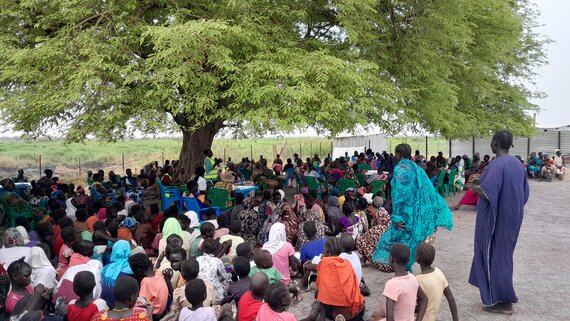Accountability to Affected Population (AAP)
Humanitarian partners are dedicated to advancing AAP and conscious community engagement. Collaborating closely with the Inter-Cluster Coordination Group (ICCG), the Communication and Community Engagement Working Group (CCEWG) will focus on creating collective, streamlined, and contextually relevant AAP monitoring mechanisms. These include community engagement to understand their priorities, advising on trends, reporting, and ensuring that AAP remains a core aspect of humanitarian action. Systematic and routine perception monitoring will be conducted to reflect the priorities and preferences of affected communities. It considers variations in self-identified needs among diverse population segments, including gender, age, ethnicity, and ability. Affected populations will be placed at the forefront of decision-making processes.
Please click here to access the AAP Strategy for South Sudan.
Protection against Sexual Exploitation and Abuse (PSEA)
A PSEA task force is in place, and its core functions encompass engagement with affected populations, SEA prevention, establishment of reporting systems, victim assistance, referral for investigations, and coordination. The PSEA task force is a multi-agency body comprising UN entities, NGOs, the International Committee of the Red Cross (ICRC), and protection-related sub-clusters. PSEA is mainstreamed across various programs, including needs assessments, capacity building, community engagement, and awareness initiatives. To bolster PSEA efforts, a dedicated United Nations Country Team (UNCT-HCT) PSEA Coordinator supports senior leadership and strategy development.
New SEA referral mechanisms have been established in response to crises, complementing existing complaint channels. The task force follows standardized operating procedures for SEA prevention, reporting, response, and accountability. A 2023 deep-dive review and nationwide SEA risk assessment will inform the new systemwide PSEA strategy slated for completion in December 2023. The UNCTHCT's 2024 action plan is centered on five key outcomes: staff awareness of conduct standards, secure reporting avenues, quality victim assistance, swift investigations, and strengthened senior management support. Priority actions include finalizing the 2024-2026 PSEA strategy, establishing SEA referral systems, enhancing risk management, mobilizing resources, and building capacity among NGOs. These efforts aim to strengthen accountability and effectively address SEA at national and sub national levels.
For details, please refer to the PSEA workplan on the link here

Canal/Pigi, Jonglei State
SSHF health and nutrition project implemented by an Implementing partner.
OCHA/Maureen OyeruLocalization
The HCT is committed to localization, as articulated in its strategy. Prioritizing equitable partnerships, the HCT promotes robust and mutually empowering collaborations with local and national actors. The aim is to nurture equitable partnerships, leveraging local actors' unique strengths and insights to elevate humanitarian responses' quality and timeliness. The HCT will enable capacity-building initiatives, drawing upon indigenous knowledge and practices to empower communities and local/national actors to effectively identify and address their capacity gaps, fostering a more reciprocal and mutually beneficial relationship among diverse stakeholders. The HCT is committed to ensuring meaningful representation, participation, and leadership of various actors in humanitarian coordination. The HCT will seek to mirror the priority needs of communities, encompassing risk-sharing and support for local actors' core costs and organizational development.
Please click here to access the HCT Localization Strategy.
Gender
Emergencies and crises worsen gender disparities and vulnerabilities, resulting in a rise in GBV among women and girls. Factors such as gender, age, disability, health, social status, and ethnicity influence how individuals are affected by and respond to emergencies. To address this, a collaborative and agile response involving multiple stakeholders is vital, emphasizing gender integration and inclusion in rapid assessments and cluster response plans. Efforts have been made to engage with diverse groups, analyse their distinct needs and vulnerabilities, and use this evidence to shape responses. These efforts have identified the most at-risk population groups, including persons with disabilities, the elderly, and adolescent girls and boys who face unique challenges in humanitarian settings. This approach assists in prioritizing actions to align available resources with targeted interventions.
The ICCG is critical in integrating gender and inclusion into planning and responses. Disaggregated data collected through 5Ws reporting informs planning and response strategies across various clusters, focusing on households led by women or girls and addressing gender-related constraints, particularly in sectors such as Food Security and Livelihood (FSL). The GBV information management system contributes to the prevention and response to GBV by analysing vulnerabilities and drivers. Ongoing efforts are to integrate GBV services into other cluster activities, fostering a multi-stakeholder approach. Looking ahead to 2024, there is a commitment to prioritize and deepen the gender and inclusion approach in humanitarian action, including through the Flagship Initiative focusing on community engagement. The HCT compact remains instrumental in providing strategic leadership for gender equality, with the development of minimum gender commitments and an accountability framework to guide humanitarian planning and responses.

